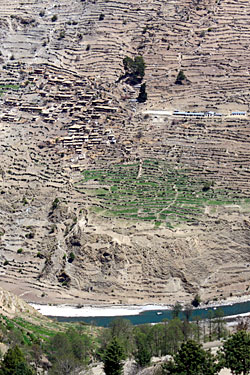 KUNDA DIXIT |
In Nepal today we are closer than ever to real peace with the seven-point deal reached on 1 November on integration and rehabilitation. At a time when we are thinking about the future, it is important to analyze our feelings that war is somehow 'special' and peace is somehow 'normal'. In fact, what happens during peacetime often makes possible the next conflict, the next war, and the next atrocity.
As a student of politics and human rights I have come across the work of anthropologist Nancy Scheper-Hughes, who argues that one way to understand the violence of war is to look at the hidden violence that goes on during peacetime. The everyday violence of 'normal' times goes unnoticed and is accepted by society at large, often in the name of 'security'.
November 2006 was a big turning point in Nepal's history. Ten years of conflict officially came to an end as the government and the Maoists signed a Comprehensive Peace Accord. Yet many of us were uncertain about whether this ceasefire would hold. The first unsuccessful ceasefire with the Maoists four years earlier ended dramatically with attacks in 42 districts and the king's declaration of emergency that followed.
I remember that ceasefire well. On 7 September 2001 I was forced to join the Maoists in my home district of Mugu as a 'motivator'. I was chosen in part because I was young (only 14 then) and had completed Grade 8. The Maoists used the ceasefire to mobilise their forces and they were expanding their presence in Mugu. For two weeks in the Maoist camp I had to attend classes to learn how to 'motivate' and train for self-defense. There were hundreds of other young boys and girls with me, some had been forced, and others were volunteers. Together we listened to instructors discuss Mao, Marx and Lenin.
We were taught how to go into villages at night and form committees to advocate social equality, to work to end caste, class, and gender-based discrimination. We walked for hours and hours, sometimes for 22 hours straight. I went with a group of ten Maoists one day, and watched as they took food saved for the winter from an elderly woman's house. She was crying as they left.
Fifteen days later I told them I had become a true Maoist, but I wanted to go home one last time and say goodbye to my father. Instead, I left the district and went into hiding in India and later within Nepal as the war started again. For many, the ceasefire was about preparing for war, not peace.
Maoist violence was being countered by the state. The Armed Police Force (APF) was established during that ceasefire period because Nepal Police was proving inadequate to fight the insurgents and the king refused to use the Royal Nepal Army to fight the guerrillas.
The APF was officially set up on 24 October 2001, and many young people who had suffered under the Maoists joined the newly formed paramilitary force. The APF's stated mission was to control 'acts of terrorism and the associated trend of organized crime'. The Maoists were officially declared 'terrorists' around this time.
Just as I was sent to mobilise villagers by the Maoists, the APF was sent out to 'protect' citizens from 'terrorists' during the ceasefire. For both the government and the Maoists, a ceasefire was a time to take a breather, to consolidate, re-mobilise, rest and prepare for the war to start again. It was a tactical break to enable a longer war.
The current ceasefire has lasted five years. But we are still trying to sort out the legacy of the conflict and it even seems like the Nepal Army, the APF and the Maoist army are warily circling each other. The new deal may create an integrated Nepal Army, but there is a lot of uncertainty about how it will go. A ceasefire is a time to build peace, not prepare for another war.
Today �" even if we are lucky �" we will have three security forces (NA, APF, and NP). Yet some would say that even one professional army is too many for a republic.
Dhana Laxmi Hamal is a senior at Bard College in New York.
Read also:
Nearly there
Nepal is taking money away from public welfare to rehabilitate and compensate Maoist warriors. But it may be the price we have to pay for peace.
A war of words, RUBEENA MAHATO
Fighter turned writer has doubts about whether the revolution was worth it
he five-year ceasefire, EDITORIAL
No war, no peace, RUBEENA MAHATO
No surprise that we have all forgotten the fifth anniversary of the Comprehensive Peace Accord this week
The way ahead, KUL CHANDRA GAUTAM
The 1 November agreement breathed new life into the Comprehensive Peace Accord five years after it was signed.



